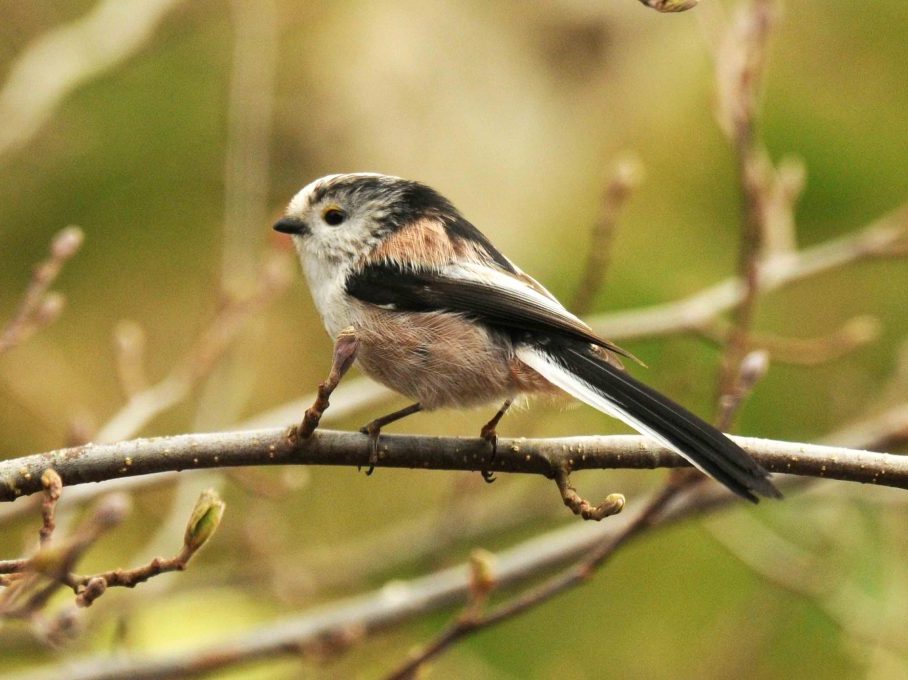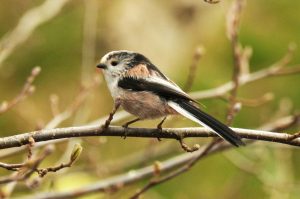
This is an extended version of an article, ‘British wildlife in lockdown’, that appears in the June issue of British Wildlife.
Amid the enduring difficulties of the COVID-19 pandemic, it has been heartening to see the resourcefulness, resilience and imagination shown by the naturalist community. To give a taste of this, we asked our British Wildlife contributors how they had spent their time through late March and April, when restrictions were at their tightest. Here we give you the delightfully varied responses that came back. I hope that readers enjoy this snapshot of life in lockdown for the naturalist.
A spectacular spring
The start of lockdown coincided with a most exceptional run of fine spring weather (April was duly confirmed by the Met Office as the sunniest since 1921). While it was somewhat torturous to watch this unfold from the confines of our homes, time outdoors was all the more invigorating for it and the usual spring arrivals and emergences were met with even greater joy than normal.
A number of our regulars have tracked the changes as spring progressed, and Simon Leach has been encouraging local recorders to do the same: ‘I’ve been recording first flowerings since 2008 in the Taunton area, replicating (sort of) a similar exercise undertaken by Walter Watson in the first half of the twentieth century. And this year, constrained by “lockdown”, it seemed like a good idea to “widen the net” to get others in Somerset recording first flowering dates as well.’ By late May more than 35 participants had been drawn to the cause, and their recording from the height of lockdown through to the time of writing, in late May, has highlighted an extraordinarily early spring: Common Dog-violet Viola riviniana, Greater Butterfly-orchid Platanthera chlorantha and Biting Stonecrop Sedum acre, for example, have all had their earliest first flowering dates since Simon started the initiative.
Spring seemed to arrive early farther north, too, as Michael Scott notes: ‘Lockdown in the northwest Highlands is not too different from normal life here, but with few tourists and without the incessant afternoon hum from the rush hours of transatlantic jets. April 17th was a red-letter day. As I ate breakfast, I spotted the first Swallow of the year. Going outside, I heard the first Cuckoo from the adjacent hill. Later, a distinctive off-key scolding from the coastal bay below the house told us that the Common Sandpipers were back, too. They were respectively one, four and two days earlier than we recorded last year, but I suspect that may just reflect more observer effort!’
And it was not just summer migrants and wildflowers that were making early appearances, but also spring invertebrates. David Christie, copy checker for BW, noted the following from his home in Southampton: ‘Among the highlights were the garden’s earliest ever Dark-edged Bee-fly, on 16th March, a pleasant sunny day which also produced a Comma, a Small Tortoiseshell and two Brimstones. On 26th, an astonishing addition was a single male Wood White, unsurprisingly the first ever for the garden — but some 6 weeks too early! I imagine that this, the daintiest of the whites, was bred and released by somebody nearby (several people have released butterflies in the area in previous years). In April Orange-tips became the commonest butterfly, and on 16th of that month a Red-tailed Bumblebee, supposedly a common species but a garden first, turned up; it stayed for several days but had apparently disappeared by the middle of the following week.’
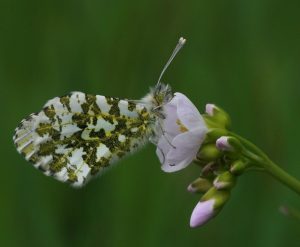
Peter Marren has enjoyed tracking changes on his local patch in Ramsbury, Wiltshire: ‘The sunniest side of this enforced lockdown is that I have come to appreciate home turf as never before. It helps that this has been the brightest, if not the warmest, April for some time, but this year the beauty of the meadows, woods and downs around Ramsbury has made me gasp, as if seeing it for the first time. I watched while a late spring turned into an early one. Frog spawn, flocculent and chilly, appeared in the ditch outside during the first week in March, and by the second week in April the tadpoles were already well grown. I heard the first Chiffchaff, much later than usual, on March 18th. It was joined in song by a Blackcap by March 25th. I heard the first Willow Warbler on April 5th (they are still doing well here, and have spread from the valley scrub into a belt of trees below the down, planted 15 years ago). The first Orange-tip fluttered into my garden on 9th April. The first singing Reed Warbler began –like a cold engine warming up – on the 10th, I spotted the first Swallow on the 13th and heard a solitary Cuckoo calling from the reedbed on Easter Sunday, 12th April. There was a close tie-in this year with the opening of our two cuckoo flowers, Lady’s Smock Cardamine pratensis and Lords-and-Ladies Arum maculatum. I should perhaps mention that spring usually comes late to Ramsbury. We are in a narrow east-west valley where a cold westerly blows from the Marlborough Downs and puts everything back by about a week.
‘Apart from the perennially exciting arrival of our summer visitors, I find I am looking at the small, easily overlooked things in life. This year I watched the leaves unfurl. Ash has, for once, tied with oak (so perhaps we are in for neither a splash nor a soak). Its feathery leaves push upwards in a shuttlecock from a bush of spent flowers, then angle out stiffly on their long petioles. By contrast, the leaves of oak curl softly from their buds, masked by a screen of yellow-green catkins. For a day or two, the hedgerow oaks take on an almost autumnal hue before they turn spring-green, that delicate, tender green that lifts the heart and makes you feel young again (anyone know any good oak songs?). Baby oak leaves lack the bitter tannins that build up later on. I nibble some straight from the branch – green chewing gum. Isolation makes you do strange things.
‘I’m also looking at bees. The only way I can get close to a bee is with close-up binoculars. Where banks face the sun, and especially when they are sheltered by a hedge, the mining bees are busy, locating their little, barely visible excavations, and vanishing into them bearing heavy loads of bright yellow pollen. Much of it, I note, is taken from Leylandii cones (so let’s hear it for once for that much-maligned conifer). Watching the bees at work are a whole host of parasites. On 31st March there was a brief flurry of oil beetles. Later on, nomad bees and blood bees were swarming about, each intent on laying a single egg inside the mining bee’s chamber. Patrolling bee-flies will do the same. The proper bees do not seem to notice that they are surrounded by malevolent cuckoos. Imagine a troop of hostile visitors raiding your cupboards and your fridge, sleeping in your bed, chasing away the kids. And that’s before the insecticides get you. I am glad I am not a bee. I am glad I live in Ramsbury. The swamp may be muddy yet – for the valley has taken a long time to recover from February’s floods – but it is full of life. Nature is the perfect antidote to despair in this surreal, locked-down spring.’
A number of correspondents noted what an excellent spring it has been for invertebrates, and bees in particular seem to have been popular with those wishing to use their time in lockdown to get to grips with a new group. From Anglesey, James Robertson writes: ‘I sit on a low wall, dangling my legs. After a while a queen Garden Bumblebee heads into a gap at the base of the wall by my feet. I am learning the skill my ornithologist brother tried to teach me many years ago. Then I was having none of it. Plants sat around on their bottoms, I had to search them out, keep on the move. But this year everything is different. Be still and the insects come to you. As so often, the constraints we are under force us to be creative, to learn new tricks and look at the world afresh.
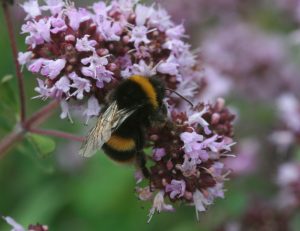
‘As the dominant hominid falls silent, nature booms and buzzes. The exceptional weather puts on a display of insect variety. Wasp Beetles bounce around my garden, flicking their antennae and not looking quite right for the wasps they pretend to be. Red Mason Bees investigate holes in concrete posts and Joanna’s Bee Hotel, a future bee smorgasbord for hungry Blue Tits. She has quickly mastered the identification of Early, Garden, Red-tailed and Buff-tailed Bumblebees.
‘My car windscreen is splattered with insect bodies. This is supposed to be a memory, how it was when we were children. Is this explosion of life a sign of what would happen if we stilled the great machine of our industrious world?’
It was not the abundance of bees but a single unexpected one that provided a highlight for our copy editor, David Hawkins: ‘I was delighted when a rather smart solitary bee appeared in my flat in Bristol, having blundered in through the window. I consulted Falk & Lewington at length, but was perplexed – trying my damnedest to make it an Andrena of some sort, although none of the candidates looked quite right. Plus it had very beautiful mottled dark blue-grey eyes. Then, using a hand lens, I caught sight of a small spike on the underside of the first sternite – this, apparently, is diagnostic of a male Spined Mason Bee Osmia spinulosa. It seemed very curious to encounter it in the middle of the city, but we live near a railway line and some allotments so there may well be suitable habitats there. Most interestingly, as with some other Osmia spp., it nests inside vacant snail shells.’
While lockdown may have produced a new generation of bee enthusiasts, it was perhaps not such a good time to pick up an interest in flies. Alan Stubbs reports that his garden ‘is almost bereft of hoverflies; yesterday I achieved the fourth species for the March–April period and I have never seen more than two of any on a lap of the garden. Flies as a whole are very sparse even now (23rd April), a shame in the lockdown. The current drought does not help, but there is a legacy effect from low populations and drought last year. The excessive winter rains have not been of benefit (and have possibly been a negative factor). Currently it is difficult to know how widespread the doldrums extend, but I suspect areas that have had more rain over the last four to six weeks will have fared a bit better. Reports from London and Warwickshire suggest I am not alone.’
Bringing wildlife to you
While opportunities to go out into the wider countryside were limited, many found ways to bring wildlife to their doorsteps instead. Moth-trapping has seen a surge in popularity, as Paul Waring explains: ‘Moth-trap operators are better placed than many wildlife enthusiasts to cope with lockdown arrangements. Most of us routinely operate a light-trap in our gardens, and some do so on verandas and roof-tops if they have no garden. With a light-trap the moths come to us, from the garden itself, and from beyond it, so we do not need to leave our home to record what is about. The numbers and variety of moths in the catch and the seasonal patterns of occurrence always hold some interest, even in inner city locations. One is sometimes amazed at what turns up. Facebook has been full of people reporting their garden catches, often including photos of the moths, sometimes with lively discussion, throughout the lockdown period.’
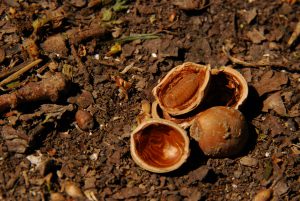
The staff at Butterfly Conservation, unable to get out into the field, have also focused on moths in their gardens. Mark Parsons tells of some early highlights: ‘During lockdown the conservation staff at Butterfly Conservation were encouraged to run a moth trap at their homes. At least 28 staff participated, with traps being run from Devon to Cambridgeshire and north to Deeside, as well as in Northern Ireland. Although there were a few cool evenings in the first three weeks, generally conditions were relatively mild and very suitable, and as a result there were a lot of interesting observations. Of the scarcer species there were records of Silver Cloud Egira conspicillaris (Worcestershire), Small Eggar Eriogaster lanestris (Dorset), Marbled Pug Eupithecia irriguata (Devon) and the micro-moth Mompha divisella (Dorset and Glamorgan), with a Light Orange Underwing Boudinotiana notha (Surrey) being seen by day. Other interesting records included high counts of Lunar Marbled Brown Drymonia ruficornis (56) and Frosted Green Polyploca ridens (31), both on 11th April in Surrey. It really is amazing what can be found in gardens!’
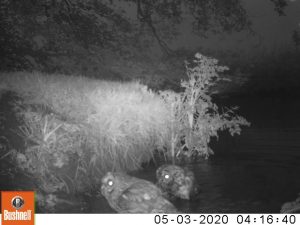
BW’s Founding Editor, Andrew Branson, has been making good use of other technologies to monitor goings-on in his garden: ‘So often when we are observing the natural world we are looking at it from a very narrow perspective both in time and in space. We return to our favourite haunts looking for confirmation of the same species – the anxious scanning for returning migrants is a classic expression of this. I am always struck by the way we have a mental search pattern that reinforces what we expect to see. A classic is the way botanists with their stooping gaze on the ground will often fail to record unusual tree species right above them. In lockdown I have been trying to extend my appreciation of garden species by using a webcam to record nocturnal life. I’m lucky enough to have a garden that reaches down to a river, and have been discovering that not only do we have the expected Brown Rats, Mallards and Moorhens making regular nightly visits, but our garden also seems to be on the rounds of an Otter, an American Mink (not so welcome), Hedgehogs (first I’ve seen in the garden for years), Roe Deer, Foxes and Rabbits. Recently, the webcam captured a furtive pair of Tawny Owls having a midnight bath in the river!’
Dave Wilkinson has spent time studying some of the more obscure lifeforms in his pond: ‘Lockdown natural history: in the imagination it is snow leopards and camels as I read George Schaller’s new book Into wild Mongolia, while in reality it’s restricted to the garden and occasional short walks. In February we had a new garden pond dug, with the first water plants going in just before lockdown. With few ponds nearby it quickly attracted birds, hedgehogs and wasps; to drink, wash, or forage along the edge. Water beetles, pond skaters and water boatmen quickly followed. New ponds tend to be prone to algal blooms and ours is no exception. The torrential rains of February washed surrounding soil into the newly dug pond, adding nutrients, then the warm sunny weather of April powered algal photosynthesis – the pond first scummed with ‘blanket weed’, then turned bright green with cyanobacteria and other algae. Without lab access (no plankton net or centrifuge) some ingenuity allowed me to concentrate some plankton to view with a rather basic 50-year-old microscope. With such equipment colonial cyanobacteria – such as Aphanocaspa – were easier to isolate than smaller cells. The floating ‘blanket weed’ quickly vanished, but small patches of filamentous algae are in the shallows, including the green alga Stigeoclanium. Under the microscope these threads have the look of cells-within-cells, with small round green structures within the longer tubular cells. These structures are chloroplasts, the site of photosynthesis with the product stored as starch, staining dark when I added iodine. Back in the depths of geological time these chloroplasts evolved from free-living cyanobacteria; down my microscope I am seeing the history of our emerald planet encapsulated in the green scum of a garden pond.’
And in the terrestrial realm, Roy Watling has also been looking at some smaller organisms in his garden in Edinburgh: ‘Some years previously, when I was recovering from a medical procedure, I had to make time for exercise. I walked around the streets close to my house, gradually increasing the distance each day; I could not resist the temptation to “mycologise” though and began to list all the micro-fungi found on the vascular plant cultivars I saw in each garden. Now I am confined to my own garden because of lockdown I decided to conduct a similar survey, with surprising (to me at least) results. Thus, the tips of shoots of Irish Tutsan Hypericum pseudohenryi hosted the mildew Erysiphe hyperici, which is not uncommon on our native plants, while hidden among the erect branches of the snowberry Symphoriocarps x doorenbosii was another mildew, E. symphoricarpi. These two species are not rare but are poorly recorded in Scotland, and certainly neither has previously been recorded here on these hosts. The true mould Ampelomyces quisqualis, a parasite of a range of mildews, is equally under-recorded, although can be obvious to the keen observer. Also evident in my border was blotching on the shrub Hebe x francisciana: a rather distressing sight caused by the fungus Septoria exotica. On the north facing side of the house where it is moist and shaded, Chaetothyrium babingtonii grows prolifically in a mixed planting of various Rhododendron cultivars and hybrids. This fungus is common and widespread under the right conditions, and although it does not appear to harm the plants it looks very unsightly – thank heavens it only occurs on Rhododendron!’
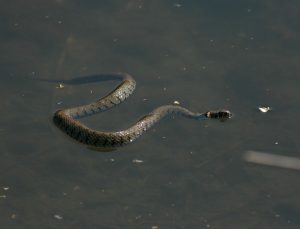
Frances Dipper has been observing the interactions between some more familiar species: ‘The human brain is much better than a computer algorithm at picking out patterns (hence ‘Galaxy Zoo’ – the web-based project that uses citizen scientists to classify distant galaxies based on their shape) so changing from recording fish (and other marine life) to birds and garden wildlife is proving to be a fascinating experience during lockdown. Seashore recording and diving are time-limited, but looking out at a habitat resource (i.e. the bird feeders in my large, wildlife-friendly garden) is not. As a marine biologist learning to be an ornithologist, here are some recent observations. Some Greenfinch Carduelis chloris prefer to spray out sunflower hearts from the feeder and then eat at their leisure on the ground below – memories of rich arable field pickings? Much smaller Goldfinch Carduelis carduelis will hold their ground (perch) on the feeder in the face of Greenfinch bully tactics. Starling Sturnus vulgaris are now adept at clinging on to feeders – perhaps our Cambridge ones are fast learners. Great Tit Parus major will nest in vertical holes, in this case a hollow brick column. There is also a Magpie Pica pica nest in our oak tree. A faithful Spotted Flycatcher Muscicapa striata pair used to nest every year in the same vine until a Magpie raided its nest a few years ago. The best sighting to date? Not a bird but a Grass Snake Natrix natrix swimming across the pond and obviously unaware that Great Crested Newt Triturus cristatus is a protected species! Now how did one of the latter get into my downstairs shower room?’
And the extra time at home allowed Michael Scott the chance to notice garden visitors who might have gone undetected in a normal year: ‘Freedom from urgent deadlines has meant more time to observe how regularly a pair of Yellowhammers come to join the Dunnocks and an occasional fat Bank Vole feeding on the grain that ungrateful Chaffinches and House Sparrows regularly scatter onto the ground from our bird feeders. A small group of Long-tailed Tits in early April was a first for the garden. One was collecting the frayed ends of some garden string, presumably for a nest somewhere in the area.’
David Christie noted some apparent effects of the lockdown itself on the birds in his garden: ‘Perhaps the most notable feature of April–May was that many birds were becoming unusually tame. When I was “tidying” a corner of the garden, an adult female Blackbird walked around my feet, picking up odd items of food; feeding within a few centimetres of my feet, she occasionally looked up at me to check what I was doing! The visiting Stock Doves, too, were tamer than usual. On 24th April, a pair of Blackcaps had begun nest-building just a metre from our back window; although several Blackcaps regularly spend January–April in the area, they have never before nested here (sadly, the pair deserted at the laying stage). By the end of the month, a Blackbird pair with three fledglings showed no fear of humans, nor did a fully independent young Robin.’
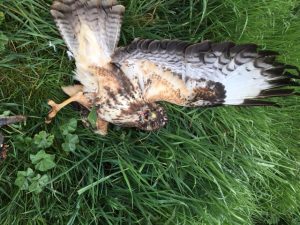
And Hugh Raven similarly has been musing on the possible effects of lockdown on the wildlife of his local loch and beyond: ‘Float over the deep belly of our local sealoch and look north, and you spy two rivers as they reach the sea – in plan like the outstretched arms of a mermaid’s purse. Embraced by these limbs is a verdant turf of saltmarsh fringed by a pancake of sandy mud, twice daily exposed when the tide recedes. At this time of year, it’s the haunt of sawbills. Goosanders and mergansers are by nature shy and flighty, but this year they are abundant. With human traffic around the loch and up these rivers – never heavy – a fraction of the norm, having eaten their fill they laze about on foreshore and saltmarsh preening in the spring sunshine. I counted 18 one day in late April. Sawbills are good at fishing. Research from Norway reports “adult goosander on average eat from 310 to 500g fish a day”. At this time of year they’re enjoying the feeding opportunities presented by the smolt run – that evolutionary miracle that sees juvenile salmon pour downstream as maturity, light and temperature tell them to reset their osmotic meter, leave fresh water and start to fatten up in their marine phase.
‘Salmon smolts weigh some 20g, so if they are the main source of food, each duck may eat twenty or more a day. Thousands will disappear down their gullets. The local river is noted for the freshwater pearl mussel – which depends on migratory salmonids to survive. You can get a licence to shoot sawbills, but there’s no appetite for that here. Salmon and pearl mussels, or these beautiful sleek and shiny ducks? Such are the dilemmas of conservation.’
Natural history online
The lockdown experience would surely have been very different had it happened in the not-so-distant past. Social media, and the online world in general, has changed our hobby and helped naturalists to stay connected throughout this period (see Brett Westwood’s column in this issue for more on this topic). Members of the birding community, for example, have been enjoying the rapid sharing of news, and a healthy element of competition, while working on their ‘lockdown lists’.
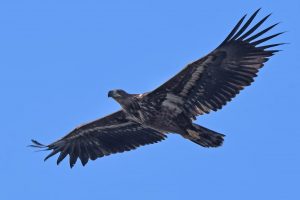
Dawn Balmer reports: ‘The movements of the released White-tailed Eagles from the Isle of Wight have been well tracked by the birdwatchers fortunate enough to spot them flying over their gardens (see https://bit.ly/2X5YXlK). I’ve also been amazed how many people have recorded Osprey over their garden, too! Both species seemed to have avoided airspace over our garden, though we were lucky enough to see two Cranes circling overhead on 20th May.
‘The first few nights of April saw a large passage of Common Scoters overland. While not a new phenomenon, it has never been documented so well. Birders stood in gardens and listened in the dark, others set recorders to record overnight – see https://bit.ly/3e5ejhj for a summary. Personally, we sat outside in our garden in Thetford (Norfolk) on the nights of 1st and 2nd April and heard Teal and Wigeon on the 1st, and Wigeon again on the 2nd. We’ve since added Moorhen to our house list – heard one fly over calling at 3.45am, and Dunlin, which flew over calling at 10.30pm one evening! With a bit more time on people’s hands, more have taken up “nocturnal migration” recording.’
Adrian Knowles has been monitoring the Facebook pages of the Essex Field Club, which has produced some notable records through lockdown: ‘Rob Smith posted a picture of the fly Bibio venosus from his daily walk patch, Headley Common in south Essex. Apparently there are only two other records in Essex, both in the north of the county. He has also recorded the mining bee Andrena cineraria from the same site – this species remains a scarce in Essex. There were two records of the ladybird Rhyzobius forestieri, a recent colonist of the UK, including one in someone’s garden. Then, on 10th April, Ed Hardy grabbed a load of wood chip during his morning walk with a view to identifying contents during his lockdown time. His finds included the beetle Rugilus angustatus, which is rare in the county, with a lack of recent records.’
Martin Harvey, David Roy and Helen Roy offer some insight into the effect of lockdown on submissions to iRecord, the online biological recording system maintained by the Biological Records Centre (part of the UK Centre for Ecology & Hydrology): ‘April 2020 proved to be a busy month with over 100,000 records added, up from about 75,000 in April 2019. It’s hard to know how much of this increase is the result of people taking up wildlife recording as an activity while locked down close to home, and how much is due to the combination of overall growth in records arriving at iRecord and the sunny weather that many experienced during April. But there do seem to be some changes in the patterns within these records. Not all biological records state the habitat that they were recorded in, but for those that do there has been a clear shift, with the proportion of records assigned to gardens more or less doubling, and a big fall in the number of records assigned to “wilder” habitats such as woodlands and grasslands. The most frequently recorded species during the month have been typical garden visitors, including butterflies such as Orange-tip and Peacock, the Dark-edged Bee-fly, Hebrew Character moth and Buff-tailed Bumblebee.’
‘Records arriving in iRecord are checked and verified by expert naturalists on behalf of the national recording schemes. An impressive three-fold increase in verification during April 2020 compared to the previous year is testament to the dedication of these people, and no doubt also demonstrates they have been making good use of the time that might have been spent in the field during a different year.
‘What effect these changes will have on the total pool of records available for 2020 remains to be seen, but it will be exciting to consider the ways in which these records can contribute to the long-term analyses that BRC and the recording schemes collaborate on. In the meantime, we hope that as many people as possible have been able to find ways of connecting with nature during these unprecedented circumstances.’
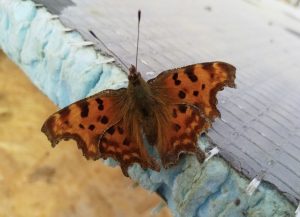
The lockdown has provided an excellent opportunity to fill in gaps in distribution maps and monitor species on the move by encouraging the submission of records. Butterfly Conservation, for example, is asking the public to report on butterflies seen in their gardens, as Caroline Bulman explains: ‘Understanding the changes in patterns of emergence and distribution across the UK is vital to improving our understanding of the impacts of climate change on butterflies and other native wildlife. Wherever you live your observations are even more vital this year and particularly those in northern England and in Scotland, where you can record novel information of species which are spreading northwards, in response to a changing climate. For example, in mid-April we had a report of the most northerly Comma ever recorded in Britain, found in Caithness on the north coast of Scotland! If you’d like to get involved go to https://bit.ly/3bM1gQk to register and download a free smartphone app, or sign up to record butterflies in your garden, on your PC or laptop at https://bit.ly/2WOQ40M where you can also read the results from 2019.’
Paul Waring used the daily exercise walks to further the understanding of moth populations in his local area: ‘During lockdown we have taken the opportunity of beating for caterpillars to start recording the colonisation by moths of a hedgerow of various native broadleaf trees newly planted to screen from view a field of solar panels. We have also carried our pheromone lure for Emperor moths Saturnia pavonia with us every day to see if the large “white hole” for this species shown just south of The Wash in the newly published Atlas of Britain and Ireland’s Larger Moths reflects lack of recording or a genuine absence. Thus far it appears the Emperor really is absent, although this is certainly not the case for many other moth species for which there is a similar white hole.’
For some groups, recording need not be limited to our time outside the house either. Geoff Oxford writes: ‘The British Arachnological Society, working with Jordan Cuff (Cardiff University), has launched two “lockdown” spider surveys that can be completed around the house and garden. One is to record the species, numbers and locations of the three British cellar spiders –the very common Daddy-long-legs Spider Pholcus phalangioides, the much less common Wine Cellar Spider Psilochorus simoni and the rare Marbled Cellar Spider Holocnemus pluchei. The second, newly launched, is to record when clusters of Garden Spider Araneus diadematus spiderlings are first noticed. Details of both surveys can be found on Twitter @BASSurveys and at britishspiders.org.uk. Response so far to the first survey has been good with some 50 people counting a total of over 185 cellar spiders, some in previously unrecorded hectads.
‘The lockdown has not seen arachnologists locking away their equipment. Initiated by Richard Wilson and Chris Cathrine, naturalists nationwide have taken to surveying their garden lawns in a two-minute sample using modified garden blow-vacs. Early results include a new spider for Yorkshire, Cryptachaea blattea. The survey has led to informed discussion via Twitter @britishspiders and #lockdownsuckschallenge, creating a forum for promoting more widely spider biodiversity in gardens. Lockdown has seen an unprecedented surge in interest in arachnids more generally; we have been inundated on Twitter.’
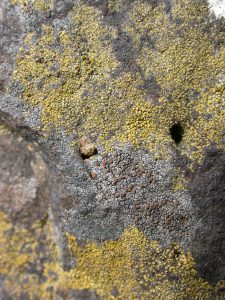
Lichenologists, too, have been getting better acquainted with their home patches, with some excellent results – Sandy Coppins reports: ‘Lichens lend themselves to “local looking” perhaps more than several other wildlife groups. BLS Twitter suggested recording lichens on your doorstep, window sill or garden, etc. But after your initial ten lichens seen on your patio slabs, where to go next? Heather Paul, in Forres, says “I amused my neighbour by going down on my knees on the pavement outside to look at Lecanora muralis which of course I have never recorded here.” While in North Wales, Dave Lamacraft on a gentle potter to look at some nearby trees, “with a view to better learning some common things in ‘normal habitats’ for a change”, was surprised to find Ramalina lacera almost straight away swiftly followed by Schismatomma graphidioides – both pretty rare in Wales!
‘But perhaps the most surprisingly fruitful and fascinating lichen results from the lockdown came from not stepping out the door: John Douglass, in South Lanarkshire, for example, writes “I was sorting through some old boxes of specimens… and came across some C[aloplaca] aractina collected from a coastal rock face on Muck (2012). I have checked it against my collections from the Lizard and the spores etc. check out good for this species.” Apart from John’s Muck revelation, C. aractina is confined in the British Isles to coastal rocks at The Lizard, in Cornwall, so this find is a lovely disjunct extension.’
To conclude
As for the BW editorial team, while we have each been left slightly envious of those people with gardens we made the most of our daily exercise walks.
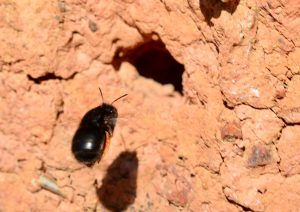
Catherine Mitson, BW‘s Assistant Editor, reports: ‘Except in times of flooding, the Exwick spillway is a popular route for runners and cyclists alike. To one side, however, is a less frequently visited footpath that follows the natural flow of the River Exe. Here, the shrubs and trees grow a little more wild, and the tall bank to the right muffles the sound of passers-by. I can now enjoy the soundtrack of my walk, featuring the nasal ‘dzwee’ of Greenfinches, the chattering of Blackcaps, melodic Song Thrushes, and the drumming of a Great Spotted Woodpecker. This was the first time I had been here, despite living so close – a direct consequence of the lockdown. I now visit this small stretch almost every day and have seen the unmistakable flash of a Kingfisher, a Dipper on two occasions, and, looking up, there are often noisy Long-tailed Tits hopping around in the branches. During the last week of April, House and Sand Martins have arrived and are now regularly seen zipping across the river as the evening sets in. The first few sunny weeks of lockdown stirred many insects; of the butterflies I have spotted so far my personal favourites include Orange-tip, Common Blue, Peacock, Comma and Brimstone. My first Dark-edged Bee-fly of the year is always a personal highlight, but this was topped as I happened across a Hairy-footed Flower Bee nesting site in a cob wall less than five minutes from my house. These strange times have certainly opened my eyes to what lies just beyond my doorstep.’
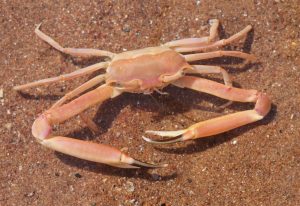
For myself (Guy Freeman), the lockdown highlights have come from strolls along my local beach here in Teignmouth which, naturally, have been timed to coincide with the best tides. The shore – mostly expanses of brick-red sand – does not look the most inspiring from a rock-pooling perspective, but I always enjoy the challenge of searching for life in these damp deserts. The walks during lockdown have been among the most productive I have had here, with favourite finds including some of the more weird and wonderful sand-dwelling specialists – the Angular Crab, which looks too exotic for these shores, and the more common but equally bizarre Masked Crab.
Many thanks to all the contributors to this piece who responded so enthusiastically to our initial call for submissions.
The contributors featured here write regularly for British Wildlife – the magazine for the modern naturalist
You can subscribe to British Wildlife here


